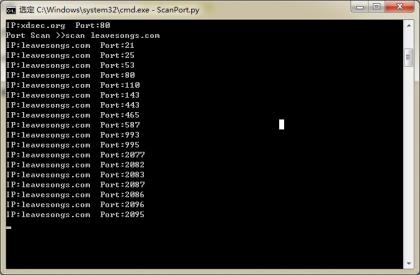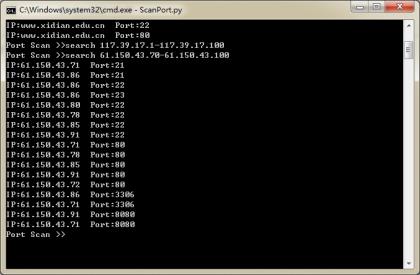Python实现的多线程端口扫描工具分享
昨晚今晚写了两晚,总算把Py Port Scanner 写完了,姑且称之为0.1版本,算是一个Python多线程端口扫描工具。
水平有限,实话中间有一些困惑和不解的地方,代码可能也写的比较乱。有些问题并未找到很好的解决方法,还望大家谅解。速度大家自己试验,我感觉还行。
送上效果图两份,分别是扫单IP和扫IP段:


源码:
# -*- coding: utf-8 -*-
__author__ = 'Phtih0n'
import threading, socket, sys, cmd, os, Queue
#扫描常用端口
PortList = [21, 22, 23, 25, 80, 135, 137, 139, 445, 1433, 1502, 3306, 3389, 8080, 9015]
#得到一个队列
def GetQueue(list):
PortQueue = Queue.Queue(65535)
for p in list:
PortQueue.put(p)
return PortQueue
#单IP扫描线程个数
nThread = 20
#线程锁
lock = threading.Lock()
#超时时间
Timeout = 3.0
#打开的端口列表
OpenPort = []
class ScanThread(threading.Thread):
def __init__(self, scanIP):
threading.Thread.__init__(self)
self.IP = scanIP
def Ping(self, Port):
global OpenPort, lock, Timeout
sock = socket.socket(socket.AF_INET, socket.SOCK_STREAM)
sock.settimeout(Timeout)
address = (self.IP, Port)
try:
sock.connect(address)
except:
sock.close()
return False
sock.close()
OpenPort.append(Port)
if lock.acquire():
print "IP:%s Port:%d" % (self.IP, Port)
lock.release()
return True
class ScanThreadSingle(ScanThread):
def __init__(self, scanIP, SingleQueue):
ScanThread.__init__(self, scanIP)
self.SingleQueue = SingleQueue
def run(self):
while not self.SingleQueue.empty():
p = self.SingleQueue.get()
self.Ping(p)
class ScanThreadMulti(ScanThread):
def __init__(self, scanIP, PortList):
ScanThread.__init__(self, scanIP)
self.List = PortList[:]
def run(self):
for p in self.List:
self.Ping(p)
class Shell(cmd.Cmd):
u'''Py Port Scanner 0.1 使用说明:
port [port..] 设置扫描的端口,用逗号分隔。
默认:21, 22, 23, 25, 80, 135, 137, 139, 445, 1433, 1502, 3306, 3389, 8080, 9015
example:port 21,23,25
example: port 1000..2000
example: port 80,443,1000..1500
scan [IP] 扫描某一IP地址
example: scan 192.168.1.5
search [IP begin]-[IP end] 扫描某一IP段
example: search 192.168.1.1-192.168.1.100
time [timeout] 设置超时时间,默认为3秒
example: time 5
cls 清楚屏幕内容
listport 打印端口列表
help 打开本帮助
'''
def __init__(self):
cmd.Cmd.__init__(self)
reload(sys)
sys.setdefaultencoding('utf-8')
self.prompt = "Port Scan >>"
self.intro = "Py Port Scanner 0.1"
def do_EOF(self, line):
return True
def do_help(self, line):
print self.__doc__
#设置端口
def do_port(self, line):
global PortList
PortList = []
ListTmp = line.split(',')
for port in ListTmp:
if port.find("..")
if not port.isdigit():
print "输入错误"
return False
PortList.append(int(port))
else:
RangeLst = port.split("..")
if not (RangeLst[0].isdigit() and RangeLst[1].isdigit()):
raise ValueError
exit()
for i in range(int(RangeLst[0]), int(RangeLst[1])):
PortList.append(i)
def do_scan(self, line):
global nThread, PortList
ThreadList = []
strIP = line
SingleQueue = GetQueue(PortList)
for i in range(0, nThread):
t = ScanThreadSingle(strIP, SingleQueue)
ThreadList.append(t)
for t in ThreadList:
t.start()
for t in ThreadList:
t.join()
def do_search(self, line):
global nThread, PortList
ThreadList = []
(BeginIP, EndIP) = line.split("-")
try:
socket.inet_aton(BeginIP)
socket.inet_aton(EndIP)
except:
print "输入错误"
return
IPRange = BeginIP[0:BeginIP.rfind('.')]
begin = BeginIP[BeginIP.rfind('.') + 1:]
end = EndIP[EndIP.rfind('.') + 1:]
for i in range(int(begin), int(end)):
strIP = "%s.%s" % (IPRange, i)
t = ScanThreadMulti(strIP, PortList)
ThreadList.append(t)
for t in ThreadList:
t.start()
for t in ThreadList:
t.join()
def do_listport(self, line):
global PortList
for p in PortList:
print p,
print '\n'
def do_time(self, line):
global Timeout
try:
Timeout = float(line)
except:
print u"参数错误"
def do_cls(self, line):
os.system("cls")
if '__main__' == __name__:
try:
os.system("cls")
shell = Shell()
shell.cmdloop()
except:
exit()

Hot AI Tools

Undresser.AI Undress
AI-powered app for creating realistic nude photos

AI Clothes Remover
Online AI tool for removing clothes from photos.

Undress AI Tool
Undress images for free

Clothoff.io
AI clothes remover

Video Face Swap
Swap faces in any video effortlessly with our completely free AI face swap tool!

Hot Article

Hot Tools

Notepad++7.3.1
Easy-to-use and free code editor

SublimeText3 Chinese version
Chinese version, very easy to use

Zend Studio 13.0.1
Powerful PHP integrated development environment

Dreamweaver CS6
Visual web development tools

SublimeText3 Mac version
God-level code editing software (SublimeText3)

Hot Topics
 1387
1387
 52
52
 Is the vscode extension malicious?
Apr 15, 2025 pm 07:57 PM
Is the vscode extension malicious?
Apr 15, 2025 pm 07:57 PM
VS Code extensions pose malicious risks, such as hiding malicious code, exploiting vulnerabilities, and masturbating as legitimate extensions. Methods to identify malicious extensions include: checking publishers, reading comments, checking code, and installing with caution. Security measures also include: security awareness, good habits, regular updates and antivirus software.
 How to run programs in terminal vscode
Apr 15, 2025 pm 06:42 PM
How to run programs in terminal vscode
Apr 15, 2025 pm 06:42 PM
In VS Code, you can run the program in the terminal through the following steps: Prepare the code and open the integrated terminal to ensure that the code directory is consistent with the terminal working directory. Select the run command according to the programming language (such as Python's python your_file_name.py) to check whether it runs successfully and resolve errors. Use the debugger to improve debugging efficiency.
 Can vs code run in Windows 8
Apr 15, 2025 pm 07:24 PM
Can vs code run in Windows 8
Apr 15, 2025 pm 07:24 PM
VS Code can run on Windows 8, but the experience may not be great. First make sure the system has been updated to the latest patch, then download the VS Code installation package that matches the system architecture and install it as prompted. After installation, be aware that some extensions may be incompatible with Windows 8 and need to look for alternative extensions or use newer Windows systems in a virtual machine. Install the necessary extensions to check whether they work properly. Although VS Code is feasible on Windows 8, it is recommended to upgrade to a newer Windows system for a better development experience and security.
 Can visual studio code be used in python
Apr 15, 2025 pm 08:18 PM
Can visual studio code be used in python
Apr 15, 2025 pm 08:18 PM
VS Code can be used to write Python and provides many features that make it an ideal tool for developing Python applications. It allows users to: install Python extensions to get functions such as code completion, syntax highlighting, and debugging. Use the debugger to track code step by step, find and fix errors. Integrate Git for version control. Use code formatting tools to maintain code consistency. Use the Linting tool to spot potential problems ahead of time.
 Choosing Between PHP and Python: A Guide
Apr 18, 2025 am 12:24 AM
Choosing Between PHP and Python: A Guide
Apr 18, 2025 am 12:24 AM
PHP is suitable for web development and rapid prototyping, and Python is suitable for data science and machine learning. 1.PHP is used for dynamic web development, with simple syntax and suitable for rapid development. 2. Python has concise syntax, is suitable for multiple fields, and has a strong library ecosystem.
 Can vscode be used for mac
Apr 15, 2025 pm 07:36 PM
Can vscode be used for mac
Apr 15, 2025 pm 07:36 PM
VS Code is available on Mac. It has powerful extensions, Git integration, terminal and debugger, and also offers a wealth of setup options. However, for particularly large projects or highly professional development, VS Code may have performance or functional limitations.
 PHP and Python: Different Paradigms Explained
Apr 18, 2025 am 12:26 AM
PHP and Python: Different Paradigms Explained
Apr 18, 2025 am 12:26 AM
PHP is mainly procedural programming, but also supports object-oriented programming (OOP); Python supports a variety of paradigms, including OOP, functional and procedural programming. PHP is suitable for web development, and Python is suitable for a variety of applications such as data analysis and machine learning.
 Can vscode run ipynb
Apr 15, 2025 pm 07:30 PM
Can vscode run ipynb
Apr 15, 2025 pm 07:30 PM
The key to running Jupyter Notebook in VS Code is to ensure that the Python environment is properly configured, understand that the code execution order is consistent with the cell order, and be aware of large files or external libraries that may affect performance. The code completion and debugging functions provided by VS Code can greatly improve coding efficiency and reduce errors.




